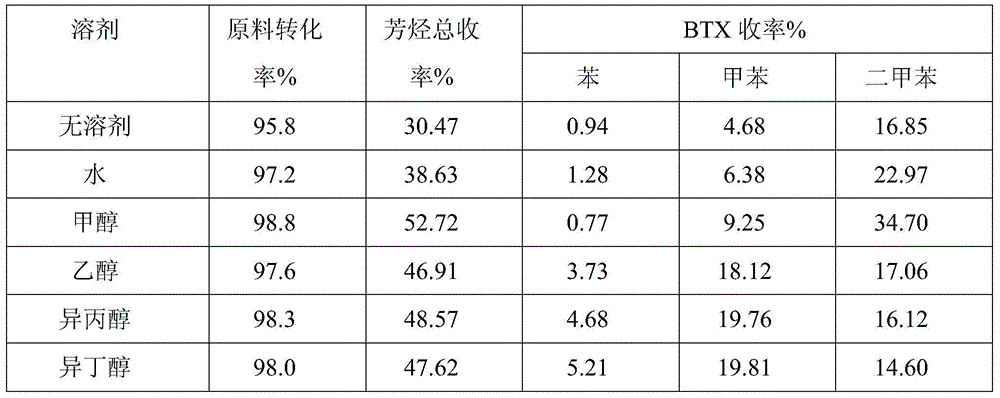A glycerin aromatization method
An aromatization and glycerol technology, which is applied in organic chemistry, bulk chemical production, hydrocarbon production from oxygenated organic compounds, etc. The effect of promoting smooth development, changing the dependence of petrochemical raw materials, and simple process flow
- Summary
- Abstract
- Description
- Claims
- Application Information
AI Technical Summary
Problems solved by technology
Method used
Image
Examples
Embodiment 1
[0020] 1) Mix glycerin with water, methanol, ethanol, isopropanol and isobutanol at a ratio of 10% glycerin mass concentration, heat and vaporize at 290°C, and then pump it into a fixed tank filled with hydrogen-type ZSM-5 molecular sieve catalyst. Bed reactor, operated under normal pressure, at a reaction temperature of 400°C and a mass space velocity of 0.96h -1 The reaction is carried out under certain conditions, and it is converted into aromatic hydrocarbon-based products through catalytic conversion;
[0021] 2) The reaction product is condensed and separated to obtain a liquid phase product and a gas phase product, the liquid phase product is separated by rectification to obtain aromatics and non-aromatics, and the gas phase product is returned to the reactor to continue the reaction.
[0022] See Table 1 for the comparison of the reaction results of Comparative Example and Example 1.
Embodiment 2
[0024] 1) Mix glycerin and isopropanol at a ratio of 20% glycerin mass concentration, heat and vaporize at 290°C, and pump them into the In a fixed bed reactor with 22 molecular sieve catalysts, operate under normal pressure, at a reaction temperature of 400°C and a mass space velocity of 0.96h -1 The reaction is carried out under certain conditions, and it is converted into aromatic hydrocarbon-based products through catalytic conversion;
[0025] 2) The reaction product is condensed and separated to obtain a liquid phase product and a gas phase product, the liquid phase product is separated by rectification to obtain aromatics and non-aromatics, and the gas phase product is returned to the reactor to continue the reaction.
[0026] The reaction results are compared in Table 2.
Embodiment 3
[0028] 1) Glycerin and isobutanol are mixed according to the ratio of glycerol mass concentration of 30%, heated and vaporized at 290°C, and then pumped into fixed-bed reactors filled with MCM-41 molecular sieve catalysts, operated under normal pressure, at The reaction temperatures are 350°C, 400°C, and 450°C respectively, and the mass space velocity is 0.96h -1 The reaction is carried out under certain conditions, and it is converted into aromatic hydrocarbon-based products through catalytic conversion;
[0029] 2) The reaction product is condensed and separated to obtain a liquid phase product and a gas phase product, the liquid phase product is separated by rectification to obtain aromatics and non-aromatics, and the gas phase product is returned to the reactor to continue the reaction.
[0030] The reaction results are compared in Table 3.
PUM
 Login to View More
Login to View More Abstract
Description
Claims
Application Information
 Login to View More
Login to View More - R&D
- Intellectual Property
- Life Sciences
- Materials
- Tech Scout
- Unparalleled Data Quality
- Higher Quality Content
- 60% Fewer Hallucinations
Browse by: Latest US Patents, China's latest patents, Technical Efficacy Thesaurus, Application Domain, Technology Topic, Popular Technical Reports.
© 2025 PatSnap. All rights reserved.Legal|Privacy policy|Modern Slavery Act Transparency Statement|Sitemap|About US| Contact US: help@patsnap.com



